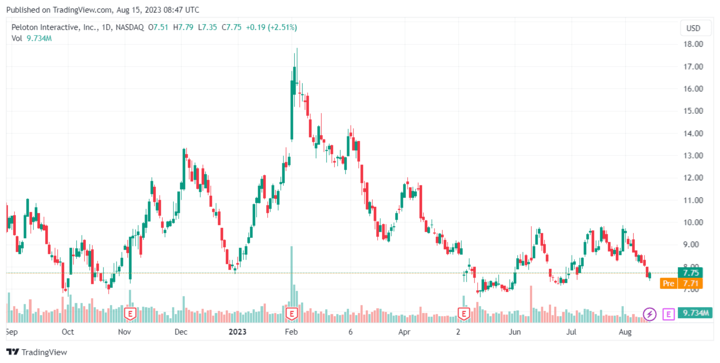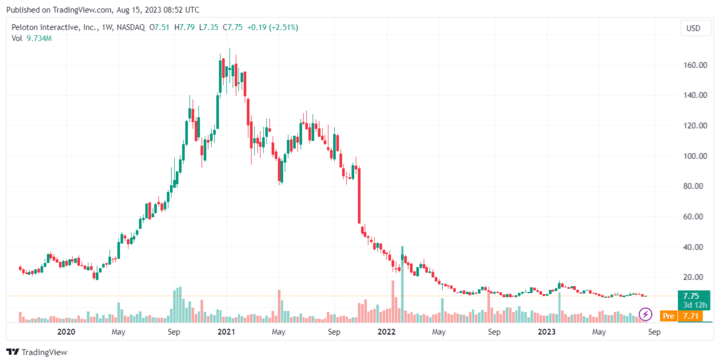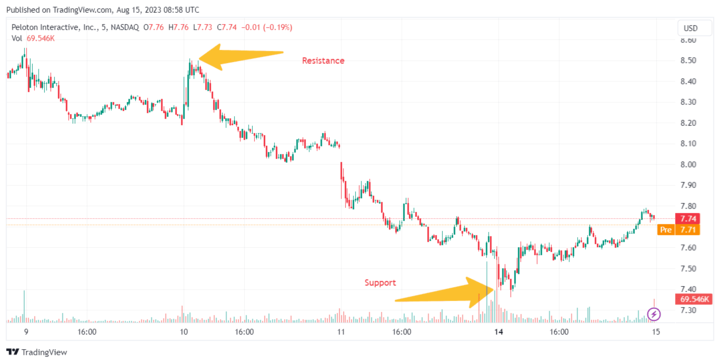Introduction
In the fast-paced world of modern investing, Peloton Interactive Inc (NASDAQ: PTON) has emerged as a prominent player, capturing the attention of both seasoned investors and novices alike. With its unique blend of technology and fitness, Peloton has become synonymous with innovation, reshaping the way we approach workouts and wellness. We're going to examine Peloton stock and its multifaceted landscape as well as navigate through its inception, growth trajectory, financial performance, stock analysis, and the compelling reasons why traders should consider PTON stock as part of their investment strategy.
But first, let's take a closer look at some of the recent noteworthy Peloton news or developments that have been shaping Peloton's path to success.
- Global Showroom Expansion: Peloton is rapidly expanding its presence by opening showrooms in key international markets, enhancing its global reach.
- Innovative Offerings: The company's continuous focus on innovation is reflected in new fitness equipment and digital products, catering to diverse workout preferences.
- Financial Rebound and Positive Guidance: Peloton rebounded from previous challenges, reporting strong earnings, and offering optimistic guidance for future growth.
Peloton Interactive Inc's Overview

Source: Rev
Peloton Interactive Inc was founded in 2012 by John Foley, Graham Stanton, Thomas Cortese, Yony Feng, and Hisao Kushi. The company is headquartered in New York City and has operations in North America, the United Kingdom, Germany, and Canada. The current CEO is Barry McCarthy, who joined the company in 2018. He has over 30 years of experience in the technology and media industries, including serving as the CFO of Netflix and Spotify. Some of the top shareholders of Peloton include TCV, Tiger Global Management, Fidelity Management & Research Company, Vanguard Group, and BlackRock.
Peloton has achieved some key milestones in its history, such as:
- Launching its first internet-connected stationary bike with a touchscreen in 2014
- Opening its first studio in New York City in 2014
- Expanding into treadmills and rowers in 2018 and 2020 respectively
- Going public on the Nasdaq stock exchange in 2019
- Acquiring Precor, a fitness equipment manufacturer, for $420 million in 2020
- Reaching over 6.6 million members and generating over $3.5 billion in revenue in 2022
Peloton Interactive Inc's Business Model and Products/Services
A. How Peloton makes money
Peloton's business model is based on combining hardware, software, and content to create a personalized and immersive fitness experience for its members. The company makes money from two main sources: connected fitness products and subscriptions.
Hardware sales: This is the revenue generated from selling its connected fitness products, such as bikes, treads, and accessories. The company sells its products directly to consumers through its website, showrooms, and third-party retailers. The company also offers financing options for its products through Affirm.
Subscription fees: This is the recurring revenue generated from charging monthly fees for accessing its content and services. The company offers two types of subscriptions: Connected Fitness Subscriptions and Digital subscriptions.
Other revenue: This is the revenue generated from other sources such as live studio classes, apparel sales, extended warranties, delivery and installation fees, and referral programs.

Source: Appexon
B. Main Products and Services
Peloton offers four main products: Peloton Bike, Peloton Bike+, Peloton Tread, and Peloton Tread+.
These are connected fitness products that feature high-quality hardware, touchscreen displays, speakers, cameras, microphones, and sensors. These products are integrated with Peloton's platform that streams live and on-demand classes taught by world-class instructors in various fitness disciplines such as cycling, running, strength training, yoga, and meditation. The platform also provides features such as leaderboards, metrics, challenges, badges, social interactions, and music playlists.
Peloton Interactive Inc's Financials, Growth, and Valuation Metrics
Peloton has been growing rapidly in terms of revenue and membership over the past few years. However, it has also been losing money due to high operating costs and investments. In this section, we will review some of the key financial statements, ratios, and metrics of Peloton.
Review of Peloton Interactive Inc's Financial Statements
The following table summarizes some of the key financial data of Peloton for the fiscal year 2022 (ended June 30, 2023) compared to the previous year:
|
PTON Earnings Metric |
FY 2023 |
FY 2022 |
Change (%) |
|
Peloton Market Cap |
$2.68 billion |
$32.89 billion |
-91.85% |
|
Revenue |
$3.58 billion |
$4.02 billion |
-10.93% |
|
Net Income |
-$2.83 billion |
-$71.6 million |
-3,854% |
|
Operating Expense |
$1.61 billion |
$1.06 billion |
+51.89% |
|
Profit Margin |
-78.94% |
-1.78% |
-4,334% |
|
Return on Equity |
-47% |
-3% |
-1,467% |
As we can see from the table above:
Peloton's profit margin has deteriorated significantly, indicating that the company is not generating enough revenue to cover its costs. The company's profitability is also affected by its high fixed costs and low gross margins. Peloton's return on equity has decreased drastically, indicating that the company is not using its shareholders' funds efficiently to generate income. The company's negative earnings also reduce its equity value.
Key Financial Ratios and Metrics
The following table compares some of the key financial ratios and metrics of Peloton to its peers and the industry as of August 11, 2023:
|
Metric |
Peloton |
Industry Average |
Peer Average |
|
P/E Ratio |
N/A |
28.6 |
30.4 |
|
P/S Ratio |
0.83 |
1.9 |
2.1 |
|
P/B Ratio |
-4.95 |
5.6 |
6.2 |
|
EV/EBITDA Ratio |
-3.9 |
16.8 |
18.2 |
As we can see from the table above:
- Peloton does not have a P/E ratio because it has negative earnings per share. This means that the company is not profitable and cannot be valued based on its earnings.
- Peloton has a lower P/S ratio than the industry and peer averages, indicating that the company is undervalued based on its sales. However, this may also reflect the market's low expectations for the company's future growth and profitability.
- Peloton has a negative P/B ratio because it has a negative book value per share. This means that the company's liabilities exceed its assets and that it has a negative equity value.
- Peloton has a lower EV/EBITDA ratio than the industry and peer averages, indicating that the company is undervalued based on its cash flow generation. However, this may also reflect the company's high debt level and low operating income.
PTON Stock Performance Analysis
PTON stock has been performing poorly since its IPO in September 2019. The stock has lost over 70% of its value from its all-time high of $172.83 in December 2020 to its current price of $7.76 as of August 13, 2023. The stock has also been highly volatile and has been trending downward over the past year. In this section, we will analyze some of the key factors that affect PTON stock price, as well as some of the forecasts and recommendations for PTON stock.

Source: TradingView
PTON Stock Trading Information
PTON stock trades on the Nasdaq stock exchange under the ticker symbol PTON. The stock is denominated in US dollars (USD) and is subject to US securities laws and regulations. The stock's trading hours are from 9:30 a.m. to 4:00 p.m. Eastern Time (ET) on weekdays, excluding US market holidays. The stock also trades in the pre-market hours from 4:00 a.m. to 9:30 a.m. ET and in the after-market hours from 4:00 p.m. to 8:00 p.m. ET.
PTON stock has not undergone any stock splits since its IPO. Stock splits are corporate actions that increase or decrease the number of shares outstanding without changing the total market value of the company. Stock splits can affect the stock price, liquidity, and volatility.
PTON stock does not pay any dividends to its shareholders. Dividends are distributions of a portion of a company's earnings to its shareholders as a reward for their investment. Dividends can affect the stock price, yield, and return.
PTON Stock Price Performance since its IPO
The following chart shows the historical price performance of PTON stock since its IPO:

Source: TradingView
As we can see from the chart above:
- PTON stock debuted on September 26, 2019, at an IPO price of $29 per share, which was at the high end of its expected range of $26 to $29.
- Peloton stock price surged to its all-time high of $176.83 on December 23, 2020, driven by the strong demand for its products and services amid the COVID-19 pandemic, which forced people to stay at home and exercise indoors.
- PTON stock price plummeted to its all-time low of $6.76 on May 5, 2023, after the company announced a voluntary recall of its Tread and Tread+ treadmills due to safety issues.
- PTON stock price has been fluctuating between $6 and $9 since June 2023, reflecting the uncertainty and volatility in the market.
Key Drivers of PTON Stock Price
Some of the key drivers that influence Peloton share price are:
- Demand and Supply: The demand and supply of PTON stock is also affected by the demand and supply of Peloton's products and services, which depend on factors such as consumer preferences, disposable income, health awareness, fitness trends, and pandemic-related restrictions.
- Competition: Peloton faces competition from gyms and fitness centers that can lure customers back as they reopen after the pandemic.
- Innovation: Peloton relies on innovation to maintain its competitive edge and differentiate itself from its rivals.
- Regulation: Peloton is subject to various laws and regulations that govern its operations, such as consumer protection, product safety, intellectual property, privacy, data security, taxation, labor, and environmental laws.
- Economy: Peloton is influenced by the general economic conditions that affect its customers' spending power and behavior.
Peloton Stock Forecast
Some of the PTON stock forecast related key indicators are:
Resistance and Support Levels
Resistance levels are prices that act as barriers for the stock price to rise above them. Support levels are prices that act as cushions for the stock price to fall below them. These levels are determined by historical patterns of supply and demand for the stock. The following chart shows some of the resistance and support levels for PTON stock based on TradingView charts:

As we can see from the chart above:
- The current resistance level for PTON stock is around $8.5
- The current support level for PTON stock is around $7
- If PTON stock breaks above the resistance level of $8.5 with high volume and momentum, it could indicate a bullish trend and a potential reversal of the downtrend. The next resistance level for PTON stock could be around $10, which was the previous support level in June 2023.
- If PTON stock falls below the support level of $7 with high volume and momentum, it could indicate a bearish trend and a continuation of the downtrend. The next support level for PTON stock could be around $5, which was the low point in March 2020.
Analyst Recommendations and Price Targets
The following table shows some of the analyst recommendations and price targets for PTON stock as of August 11, 2023:
|
Analyst |
Recommendation |
Price Target |
Implied Upside/Downside |
|
Morgan Stanley |
Overweight |
$12 |
+58.73% |
|
JPMorgan Chase |
Neutral |
$9 |
+19.05% |
|
Bank of America |
Underperform |
$6 |
-20.63% |
|
UBS |
Sell |
$4 |
-46.83% |
As we can see from the table above:
- The consensus analyst recommendation for PTON stock is Hold, with 12 analysts giving a Buy rating, 15 analysts giving a Hold rating, and 8 analysts giving a Sell rating.
- The average price target for PTON stock is $8.33, which implies an upside potential of 10.19% from the current price of $7.56.
- The highest price target for PTON stock is $12, given by Morgan Stanley, which implies an upside potential of 58.73% from the current price.
- The lowest Peloton stock price target is $4 given by UBS, which implies a downside potential of 46.83% from the current price.

Source: CNBC
Challenges and Opportunities
Peloton faces some challenges and opportunities in its industry and market that can affect its future growth and profitability. Some of these are:
Competitive Risks
Peloton operates in a highly competitive and dynamic fitness industry that is constantly evolving and innovating. The company faces competition from both traditional and digital fitness players that offer similar or alternative products and services that can attract or retain customers away from Peloton.
Some of the main competitors and competitive advantages of Peloton are:
- NordicTrack: NordicTrack is a fitness equipment manufacturer that offers internet-connected bikes, treadmills, rowers, ellipticals, and strength trainers that stream live and on-demand workouts through its iFit subscription service. NordicTrack has a longer history and wider distribution than Peloton, as well as lower prices and more product variety.
- SoulCycle: SoulCycle is a boutique fitness studio that offers indoor cycling classes that combine music, choreography, and motivational coaching. SoulCycle has a loyal fan base and a strong brand image that appeals to millennials and celebrities. SoulCycle also launched its own internet-connected bike called SoulCycle At-Home in 2020 to compete with Peloton in the home fitness market.
- Equinox: Equinox is a luxury fitness club that offers various fitness classes, personal training, spa services, and lifestyle products. Equinox has a premium positioning and a high-end clientele that values quality and exclusivity. Equinox also owns SoulCycle and launched its own digital fitness platform called Equinox+ in 2020 to compete with Peloton in the online fitness market.
Peloton's competitive advantages over its rivals include:
- Its loyal and engaged community of members who share their fitness goals, achievements, and feedback through social media, leaderboards, and groups
- Its high-quality and interactive content that features diverse and charismatic instructors who inspire and motivate the members through their workouts
- Its innovative and user-friendly technology that integrates seamlessly with its products, services, and platforms to provide a personalized and immersive fitness experience
- Its strong brand awareness and reputation that position it as a leader and pioneer in the connected fitness industry
Other Risks
Peloton also faces some other risks that can affect its business and stock performance, such as:
- Product Safety: Peloton has to ensure that its products are safe and reliable for its customers. The company has to comply with various product safety standards and regulations, as well as address any defects or malfunctions that may occur.
- Customer Retention: Peloton has to retain its existing customers and prevent them from switching to other fitness options or canceling their subscriptions.
- Regulatory Compliance: Peloton has to comply with various laws and regulations that govern its operations, such as consumer protection, product safety, intellectual property, privacy, data security, taxation, labor, and environmental laws.

Source: Bloomberg
Growth Opportunities
Peloton also has some growth opportunities that can enhance its business and stock performance, such as:
- Product Expansion: Peloton can expand its product portfolio by introducing new or improved products that can cater to different fitness needs, preferences, and budgets. For example, Peloton can launch a cheaper or smaller version of its bike or treadmill or a new product category such as a smartwatch or a wearable device.
- Content Diversification: Peloton can diversify its content offerings by adding more classes across different fitness disciplines, levels, languages, formats, and genres. For example, Peloton can offer more classes for beginners, seniors, kids, or non-English speakers, or more classes for dance, martial arts, boxing, or pilates.
- Market Penetration: Peloton can penetrate new or existing markets by increasing its sales channels, distribution networks, marketing campaigns, partnerships, and collaborations. For example, Peloton can sell its products through more online platforms or retailers.
Future Outlook and Expansion
Peloton has a positive future outlook and expansion plan that can support its long-term growth and profitability. Some of the aspects of Peloton's future outlook and expansion are:
- Product Innovation: Peloton plans to continue to innovate and improve its products to provide the best fitness experience for its customers. The company aims to launch new products that can address different fitness needs and preferences, such as a lower-priced bike, a higher-end treadmill, a rower, a strength device, and a wearable device.
- Content Creation: Peloton plans to continue to create and produce high-quality and diverse content that can cater to different fitness disciplines, levels, languages, formats, and genres.
- International Expansion: Peloton plans to continue to expand its international presence by entering new or emerging markets that have a high potential for growth and demand for its products and services.

Source: CNBC
Why Traders Should Consider PTON Stock
PTON stock is a risky but rewarding investment option for traders who are looking for a high-growth and high-return opportunity in the connected fitness industry. PTON stock has some attractive features that make it worth considering, such as:
- Strong brand recognition and loyal customer base: Peloton is a well-known and respected brand in the connected fitness industry. The company has a large and loyal customer base, which is a valuable asset.
- Growth potential: The connected fitness industry is still in its early stages of growth. Peloton is well-positioned to capitalize on this growth, as it is one of the leading players in the industry.
- Innovation: Peloton is constantly innovating and introducing new products and services. This helps the company stay ahead of the competition and keep its customers engaged.
- Financial performance: Peloton has been profitable in recent years. The company is also generating strong cash flow, which gives it the resources to invest in its growth.
Trading Strategies for PTON Stock
There are various trading strategies that traders can use to trade PTON stock depending on their risk appetite, time horizon, trading style, and market conditions. Some of the common trading strategies for PTON stock are:
CFD Trading
CFD trading is a type of derivative trading that allows traders to speculate on the price movements of an underlying asset without owning or delivering it. CFD stands for contract for difference, which is an agreement between a buyer and a seller to exchange the difference between the opening and closing prices of the contract. CFD trading has some advantages over traditional trading, such as:
- Leverage
- Short Selling
- Diversification
Swing Trading
Swing trading is a type of medium-term trading that involves holding a position for a few days to a few weeks. Swing trading aims to capture the price movements of an asset within a certain range or trend. Swing trading has some advantages over other types of trading, such as:
- Less Stress
- More Profit
- Less Risk
Trend Following
Trend following is a type of long-term trading that involves following the direction and momentum of the dominant trend of an asset. Trend following aims to capture the majority of the trend and ignore minor fluctuations or corrections. Trend following has some advantages over other types of trading, such as:
- Simplicity
- Consistency
- Adaptability

Source: Pymnts
Trade PTON Stock CFD with VSTAR
VSTAR is a leading online broker that offers CFD trading on various markets and assets, including PTON stock. VSTAR has some benefits or advantages for traders who want to trade PTON stock CFD, such as:
- Low Spreads: VSTAR offers competitive spreads for PTON stock CFD that can reduce the cost of trading and increase the profit potential for traders.
- High Leverage: VSTAR offers high leverage for PTON stock CFD that can amplify the returns for traders by allowing them to trade with a larger amount than their initial deposit.
- Fast Execution: VSTAR offers fast execution for PTON stock CFD that can ensure that traders get in and out of trades at their desired prices without delays or slippage.
- Advanced Platforms: VSTAR offers advanced platforms for PTON stock CFD that can provide traders with various tools and features to enhance their trading experience, such as charts, indicators, signals, news, podcasts, and analysis.
- Customer Support: VSTAR offerscustomer support for PTON stock CFD that can assist traders with any questions or concerns they may have regarding their trading account, platform, or transactions.
Conclusion
Peloton Interactive Inc (NASDAQ: PTON) is a leading technology company that offers interactive fitness products and services. The company has been growing rapidly in recent years due to its innovative business model and loyal customer base. However, it also faces some challenges and risks, such as increasing competition, regulatory issues, and changing consumer preferences. PTON stock is a risky but rewarding investment option for traders who are looking for a high-growth and high-return opportunity in the connected fitness industry.
There are various trading strategies that traders can use to trade PTON stock depending on their risk appetite, time horizon, trading style, and market conditions. If you are interested in trading PTON stock CFD with VSTAR, you can visit their website or app to open an account and start trading today.




